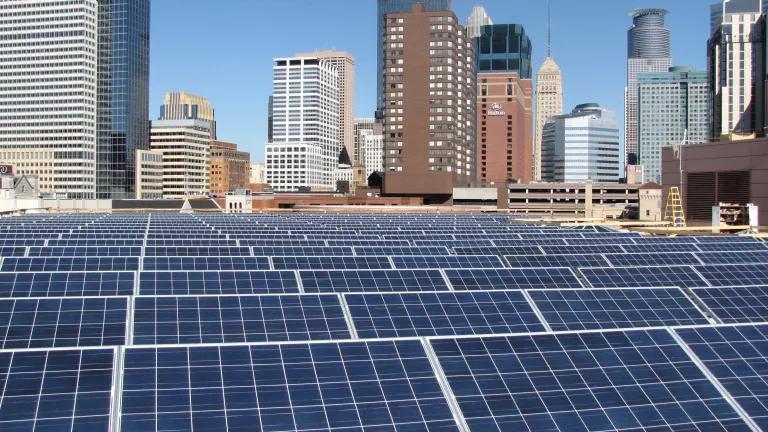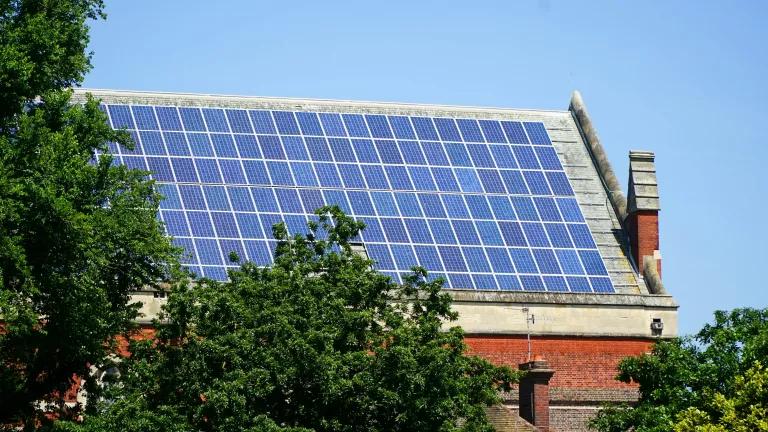Weatherization Boost Poised to Deliver Energy Price Relief
The Energy Department has announced its plan to spend $3.5 billion in weatherization funding from the recent infrastructure law.

An installer with Veterans Green Jobs weatherizes a low-income home in Denver as part of the Energy Department's Weatherization Assistance Program
In an important move that will mitigate the impact of surging energy prices on lower-income households, the U.S. Department of Energy this week announced its plan to spend $3.5 billion in funding provided under the recent bipartisan infrastructure law for the Weatherization Assistance Program (WAP)—a federal program that provides no-cost home energy retrofits to households living near the poverty level. The Department’s guidance is the first step toward getting the money to states (who administer the program) and then to households, who will benefit from lower usage and lower energy bills.
This blog provides a high-level overview of the new WAP guidance and next steps for implementation and public engagement.
What is WAP, and how can it help with the energy crisis?
Leveraging WAP to combat the current energy crisis makes sense, given that the program was originally created to help reduce and stabilize consumer energy bills during the energy crisis of the 1970s. Since then, WAP has assisted more than 7 million low-income households to save on their energy bills by providing whole-home weatherization services at no cost. The program is also impressively cost-effective – in a typical year, every dollar invested in WAP returns $1.72 in energy savings and $2.78 in other benefits, such as improved thermal comfort and health.
WAP is an especially important tool to help households struggling with high energy burdens (the percentage of household income spent on energy costs)—a population that disproportionately includes Black, Hispanic, and Native American households. A recent study estimated that WAP-eligible households had an average energy burden of 13.9 percent, far above the figure of 3 percent for non-eligible households.
Despite its benefits, WAP has been chronically underfunded. In a typical year, the program serves only 0.2 percent of eligible households.
WAP is managed by the U.S. Department of Energy, which sets nationwide program requirements and allocates funding to states. State agencies develop detailed spending plans to apply for funding from the Energy Department and manage implementation of the program.
Congress has turned to WAP before in times of economic crisis. In 2009, the American Recovery and Reinvestment Act provided $5 billion over three years for WAP as part of the government’s response to the Great Recession. Despite a slow initial ramp-up period, the initiative was a success, resulting in the weatherization of more than 1 million homes. A retrospective evaluation of the program found major benefits for participating households, including average per-household energy savings of $3,190 and average per-household total benefits (including health benefits) of more than $13,000. Notably, WAP was also one of biggest job creators funded under the Act, supporting more than 15,000 full-time jobs at its peak.
Today, the $3.5 billion from the infrastructure law presents an opportunity to deliver similar benefits to households, in a time of possibly even greater need.
What does the guidance say?
This week’s guidance from the Energy Department provides a roadmap for how it plans to spend the $3.5 billion provided by the infrastructure law. Of the $3.5 billion, $3.168 billion will be allocated to states for regular WAP program activities and technical assistance, with the remainder going toward competitive grant programs and administrative costs. Details about the competitive grant programs will be announced at a later date.
The guidance includes a list of the amounts that each state can expect to receive (available here). States will have up to 5 years to spend the funds, with the possibility of an extension.
The guidance also outlines the Energy Department’s priorities for the infrastructure funding. These include improving program implementation and flexibility; targeting the highest energy burdened and disadvantaged communities; improving integration with energy efficiency, renewable energy technologies, and electrification; minimizing deferrals; and workforce expansion and diversity. States will need to show how their spending plans meet these goals.
The Department leaves open precisely how it will comply with the Biden Administration’s Justice40 initiative, which aims to deliver 40 percent of the benefits of federal climate investments to disadvantaged communities. However, the agency commits to providing technical assistance to states and subgrantees to assist with Justice40 implementation.
What are the next steps?
The $3.168 billion will be released to states in three stages. First, states will need to prepare an application (called a “Grantee Plan Application”) and a preliminary budget estimate. After those are accepted, the Department will release an initial 15 percent of the funds to support state planning efforts. An additional 35 percent will be released after the completion of a full State Plan, which must be negotiated and approved by the Department. The final 50 percent will be released after the state has completed weatherization of 30 percent of the total planned units under the State Plan, provided that the state has complied with program requirements such as quality control and monitoring.
The Department of Energy is requiring every state to hold a formal public hearing on their draft Grantee Plan Application prior to submission. This is a key opportunity for the public to provide input on how each state should spend its weatherization allocation. Interested groups should also consider reaching out sooner to the state agency responsible for WAP, to ask about opportunities to shape the draft earlier in the process.
More broadly, the Department is encouraging states to pro-actively “engage community-based organizations, unions and community colleges committed to workforce development, diversity and energy justice” throughout the planning and implementation process.
Bottom line: State administrators need to hear from advocates and communities about how to ensure the new weatherization funding is spent wisely. Given current energy price volatility and the huge backlog of households in need of assistance, it is especially critical that the funds are invested swiftly and that states develop pro-active strategies to reach those households most in need. Reach out to your state administrator today to ask how you can get involved!
A follow-up blog will outline additional policy changes necessary to ensure that the new funding benefits those households most in need, including the need for better alignment with climate policy goals.
This blog provides general information, not legal advice. If you need legal help, please consult a lawyer in your state.


